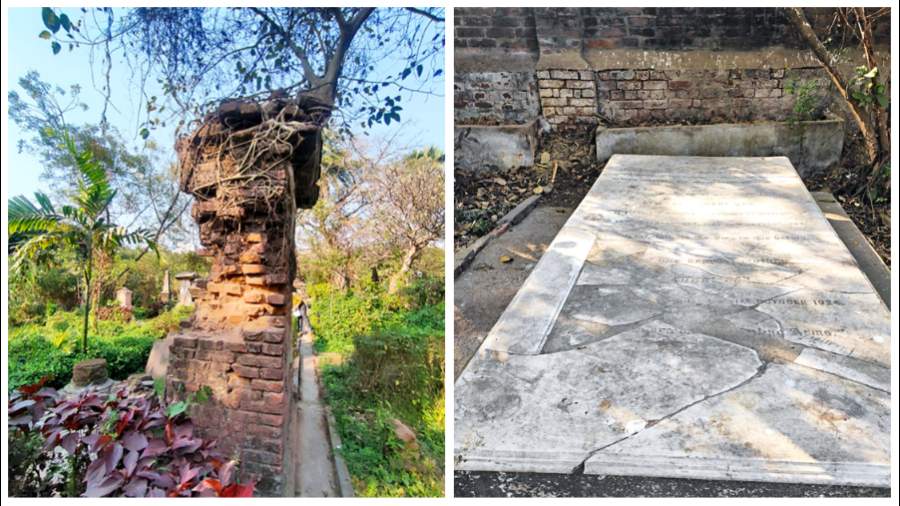The Scottish Cemetery near Mullickbazar in south Kolkata bears an outward kempt appearance with its freshly painted entry gate, a gatehouse and a Via Appia-like (Appian Way, earliest Roman road) main pathway with important tombs and graves facing it.
But beyond the main pathway, many significant graves lie derelict and disrepair.
Ensconced within a bio-diverse vegetation, the shattered tombs are often a site for local youths looking for a quiet drag.
Not far from the main pathway is the tomb of Radhanath Doss, on plot 799.
Heritage enthusiast Navpreet Arora said Doss was born into a poor blacksmith’s family in southwest Kolkata’s Kidderpore in 1826.
“He was admitted into a Bengali school and was baptised in 1832 by missionaries. He later became superintendent of schools and was a messiah for the poor. In 1844, he passed away while caring for smallpox patients. He contracted the disease himself.”
Plot number 799 is dense with vegetation. Upon asking for Doss’s tomb, the cemetery workers could identify it only by the plot number. A small plaque, broken and dilapidated, covered with earth and vegetation, is all that remains of Doss’s memory.
The cemetery records say he was a catechist and missionary, employed by the London Missionary Society.
Reverend Lal Behari Dey’s marble tomb is ridden with cracks. He was a minister and missionary of the Church of Scotland.
“Dey compiled Bengali folk tales and was a pioneer in translations. He wrote Folk Tales of Bengal in 1833. He was born in Burdwan and was brought to Kolkata by his father. He studied at General Assembly Institution. Later, he was a student at Scottish Church Collegiate School from 1834 to 1844,” said Arora.
The cemetery records say he was a professor at Hooghly College and a missionary and minister of Free Church of Scotland. He died on October 28, 1894.
Many tombs of Scottish people are in absolute disrepair, too.
Like the one of Anne Whitehead on plot 211. A vertical tomb in brick stands with a banyan tree wound around it. The cemetery records say Whitehead was the widow of E.P. Whitehead and died on February 20, 1850, at the age of 44.
Anne Eliza Bagle’s grave, too, is crying out for repairs.
“It withstood Amphan, but it can fall any day,” said a cemetery worker, referring to the devastating cyclone of May 2020.
Anne, daughter of Thos Bagley, died on June 5, 1859, of spleen enlargement.
A sarcophagus tomb of Samuel Charters Macpherson, with elaborate ornamental work, needs looking after. A bunch of youths perched themselves on the sarcophagus pulling drags on a Monday afternoon. Macpherson worked with Rammohun Roy against the practice of Sati, said Neeta Das, director of the project to revitalise the Scottish Cemetery under the Kolkata Scottish Heritage Trust.
The sarcophagus tomb was erected at the cemetery by Macpherson’s followers and admirers.
Das said the cemetery had a total of 1,809 graves of which around 300 have been restored.
“There are around 4,000people buried here,” she said.“We have graded about 1,500 graves according to their importance and aesthetic value. It is the duty of the families to maintain the graves, we maintain the cemetery. We have undertaken the restoration of graves whenever families approach us and give us funds,” said Das.
The three-acre cemetery ground is owned by St Andrew’s Church.
The cemetery was established in 1820 catering to the needs of the large Scottish population in the city and was in use till the 1940s, after which it fell into disuse.
The Calcutta Scottish Heritage Trust, a private trust in Scotland, restored the cemetery in 2008. Recently, the trust chairperson, Lord CharlesBruce, visited the cemetery and said, the trust, run by ordinary people in Scotland, without any government support, restored tombs whenever funds were available.
